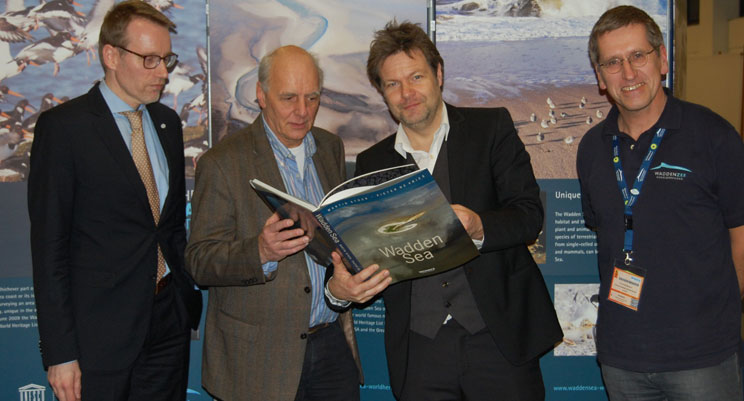Protect and Prosper: The Wadden Sea at the ITB Convention

The English version of the book “The Wadden Sea”, the first book that shows the entire Wadden Sea World Heritage Site was launched at ITB in the presence of the Minister of the Environment of Schleswig Holstein, Robert Habeck. The book contains stunning aerial photography by Martin Stock and Peter de Vries, and was produced in cooperation with CWSS (from left to right: Rüdiger Strempel, Henner Wachholtz, Robert Habeck, Harald Marencic, photo CWSS).
For the first time this year, the Wadden Sea World Heritage was represented at the world’s largest tourism convention, Berlin’s ITB, from 4-8 March 2015. Why a tourism fair?
The Wadden Sea is unique. The world’s largest unbroken system of intertidal sand and mud flats, in which natural processes can unfold in a largely undisturbed way, this area covers some 11,000 square kilometers and spans three countries: Denmark, Germany and the Netherlands. It is home to around 10,000 species of plants and animals, such as the harbour seal and the gray seal. Both species are protected under the Wadden Sea Seals Agreement, which was concluded under the auspices of CMS and for which the Common Wadden Sea Secretariat (CWSS) provides Secretariat services. But the significance of the Wadden Sea extends beyond the North Sea region. It is part of the East Atlantic flyway for birds migrating between their breeding grounds in the Arctic and their African wintering sites. Each year, 10-12 million migratory birds pass through this area on the southern rim of the North Sea, making it essential to global biodiversity.
Small wonder then, that UNESCO recognized the Outstanding Universal Value (OUV) of the region and placed it on its World Heritage list, starting with the Dutch and German parts in 2009, with the Danish part following in 2014. The World Heritage status offers tremendous opportunities but also carries certain risks. Already a tourist destination, with over 50 million overnight stays and 30-40 million day trippers, the Wadden Sea will likely attract increasing numbers of visitors due to this status. UNESCO therefore requested the Wadden Sea States to develop a strategy aimed at developing a long-term transboundary framework for the development of sustainable tourism across the Wadden Sea World Heritage destination. This strategy was adopted by the three States Parties at the 2014 Trilateral Governmental conference, held in Tønder, Denmark.
What could be a better place than ITB to underscore the need to engage with the tourism sector in order to ensure that these key stakeholders fully acknowledge and embrace their role in conserving and maintaining the integrity of the Wadden Sea World Heritage property? In addition to an info booth and a photo exhibition, the CWSS Secretariat, with the support of many partners from around the region, organized a number of events, including a panel discussion on the sustainable Tourism Strategy, involving experts from all three Wadden Sea Countries as well as UNESCO and the CWSS Secretary, Rüdiger Strempel. The English version of the book “The Wadden Sea”, the first book to show the entire Wadden Sea World Heritage Site, was also launched in the presence of the Minister of the Environment of Schleswig Holstein, Robert Habeck. It contains stunning aerial photography by Martin Stock and Peter de Vries, and was produced in cooperation with CWSS.
In line with the motto of the project “PROWAD – Protect and Prosper: Sustainable Tourism in the Wadden Sea”, funded by the Interreg IVB North Sea Region Programme, ITB therefore helped us raise awareness of the opportunities offered by the World Heritage status, while stressing that protection of the OUV is vital to safeguarding the unique character and value of the region - for the benefit of present and future generations.
Last updated on 10 March 2015


